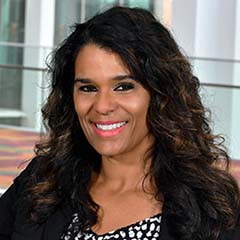
Plans for the upcoming Phase VI expansion of the Indiana Convention Center call for a new 50,000-square-foot ballroom and more than 140,000 square feet of flexible meeting and prefunction space.
The business events industry, at large, is comprised of women — 77 percent, according to the U.S. Census Bureau. But some spaces are quite the opposite, particularly facility management, where just 21 percent are women, according to the U.S. Bureau of Labor Statistics. We’re spotlighting women who have worked their way up to the top spots at convention centers around the world, and up next is Monique Wise, director of sales and marketing at the Indiana Convention Center and Lucas Oil Stadium in Indianapolis, IN.
When it comes to leadership in the events industry, there is quite a bit of disparity in the genders who fill those upper management roles — especially facility management. Why do you think that is, and what needs to change in the industry to close that gap?
I think the disparity found in our industry is quite similar to the disparities found in many other industries. Historically, women lag behind in any sector where men have traditionally dominated those leadership roles. Facility management is no different. The best way to address this and close the gap is a concerted team effort with buy-in from all stakeholders. For example, if a city’s leadership recognizes the disparity and commits to making improvements, his/her examples can set the tone for change that will spill over into many arenas. In my case, this same model is why I have been empowered to lead.

I think the consensus and the data show that virtual cannot replace the face-to-face human interaction and collaboration that conventions and other in-person events provide.”
My leadership not only recognizes the gaps but actively works to make change. An added bonus is that our city’s leadership feels the same way. For me, I have buy-in from all stakeholders and with leadership and support like this, women like myself can operate on an even playing field. I am very fortunate.
What is the biggest challenge convention facilities are facing right now? What do you see as your biggest opportunity?
There are a few challenges, but the two that immediately come to mind are virtual/hybrid meetings and staffing challenges. Virtual and hybrid options were always there, but they have been accelerated due to the COVID-19 pandemic. Staffing issues are somewhat new and foreign to our industry.
Virtual/hybrid has proven to be a necessary insurance policy for meetings should there be another global crisis like the one we faced in 2020/2021. However, I think the consensus and the data show that virtual cannot replace the face-to-face human interaction and collaboration that conventions and other in-person events provide. Thankfully, we have that reality on our side. However, the hybrid component may still translate into reduced attendance in some cases. I think we can make progress and minimize the effects of this component by maximizing and enhancing the experience that in-person meetings provide — more notably, by creating public spaces and places that are inviting, innovative, unique, and most importantly, memorable.
Staffing issues continue to plague everyone in our industry. I think being creative in where you go to find talent is crucial. Of course, utilizing the traditional avenues still work to a degree but thinking outside the box and looking in areas that you may have not considered in the past will be a must.
The design and functionality of convention facilities is changing because of the pandemic and the evolving needs of groups. From your perspective, what do you predict will change at your facility, as well as at convention centers as a whole?
One thing that we learned over the last couple of years is that each client is unique and different. Groups want options and they want to feel confident that we can accommodate them, regardless of how they choose to execute their meetings. Very early on, we added social distancing options to our traditional diagrams. They are there if a planner prefers to execute their meeting in this manner. We also upgraded our first of three food courts with a grab n’ go area to eliminate the need to interact with staff if some attendees feel more comfortable with this option. We also placed two more grab n’ go kiosks in key areas.
At the onset of the pandemic, we invested millions of dollars in permanent upgrades, like touchless toilets and sinks, building-wide hospital grade air filters, and elbow pulls on all interior and exterior doors. We invested in Clorox 360 systems so that we could provide those as an option as well. We continue to explore additional health and safety upgrades that will enhance our ability to meet the needs of our clients. I predict that the need to always provide safe options won’t end anytime soon. Our facility will always consider enhancing spaces that allow attendees to feel safe when convening and interacting in large numbers.
Jennifer N. Dienst is senior editor of Convene. This interview has been edited for brevity.
More Women Leaders
Find more stories from Convene Senior Editor Jennifer N. Dienst’s series on women leaders at convention centers.
